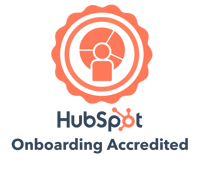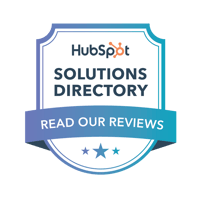Migrating to HubSpot's CRM? Congratulations! Great choice...now let's make sure it delivers.
Before you can have fun with HubSpot, you need to make sure its set up for success. Explore the essential steps for successfully implementing your HubSpot CRM - designed for beginners. Whether you're brand new to HubSpot or looking to fix an existing portal, this guide will get you up and running.
HubSpot Onboarding vs. Implementation
Onboarding and implementation go hand-in-hand, but are slightly different processes. Onboarding is the very first step after purchasing HubSpot. It's getting introduced to the system, logging in for the first time to poke around, and learning about what you can do. Implementation is getting everything set up and working as a system.
Implementation is a part of onboarding, but you can also do implementation long after onboarding. Implementation can happen at any time -- for example, if you have a new sales leader who's changing the sales process, you might need implementation to account for and optimize new processes.
Related Content: HubSpot Direct or Through a Partner Agency?
How Long Does HubSpot Implementation Take?
A successful implementation can take anywhere from one month to six months. There are a few factors that impact timelines:
- Business size and number of active users
- Complexity of data to be migrated
- Integrations required
- Degree of customization needed
- Amount of training required
- Who's handling setup and their bandwidth
Implementation is something that you don't want to rush, as a botched implementation will make your HubSpot mostly useless and impact usage by your team.
HubSpot CRM Implementation Checklist for Beginners
□ Configure account settings and create users
The first step for any HubSpot implementation is getting your account set up. After logging in, you'll want to start with some basic setup:
- Set up your company branding (tutorial here)
- Connect your domains (tutorial here)
- Connect apps and integrations (tutorial here)
- Wait to turn on data syncs! For now, just connect your apps.
- Connect your social accounts (tutorial here)
- Install HubSpot's tracking code (tutorial here)
You'll also want to add team members to HubSpot as users and set their permissions. I recommend waiting to send invitations to users until you get to step 10 in this checklist. New users will be itching to log in and explore the system. Which is what we want them to do...just not while you're still getting the system set up. Wait until it's ready to add them.
□ Define internal processes
You'll need your internal processes nailed down before you begin implementation, as they will guide how you do your setup. Processes can include:
- How new leads come into your CRM, and how they are managed
- Sales stages, pipelines, and forecasting processes
- Customer service workflows
- How data is organized, maintained and governed
- Team collaboration and where handoffs happen
- Compliance and regulatory considerations
I recommend going the extra mile and actually writing your processes down. It's going to make it easier to reference during implementation.
□ Create pipelines
Pipelines are a core component of HubSpot's CRM. Pipelines take your internal processes and translate them into stage-based activities. For example, you may have a sales pipeline that tracks the various stages a lead takes before they finally become a customer. This can include steps like meeting booked, proposal sent, and deal closed.
You'll want to create a pipeline for each key process that you identified and defined in step 3. Dive into this tutorial from HubSpot on how to actually create those pipelines in the system.
□ Migrate data
This is often the most important...and most time-consuming step. Data migration is a big beast to tackle, even if it sounds simple on paper:
- Cleanse your existing data (remove duplicates, clean up redundant and overlapping datasets, flag contacts and data that don't need to migrate over)
- Review HubSpot's standard properties to identify what custom properties you'll need to set up
- Create an architecture map to define how your existing data will map into HubSpot's properties
- Do a test run on a small import
- Start importing data via spreadsheets and integrations
- Make sure everything came over the way it was supposed to
This is where a majority of implementations fail, because it requires so much time and attention to do right. If you skip a step, you'll find that you can't do most of the cool stuff you're supposed to be able to do in HubSpot.
Seriously: take. your. time. And work with an expert if you need to. There's a reason why HubSpot agencies exist - and it's because this stage of the implementation process alone is a full-time job.
Related Content: Top 10 CRM Data Migration Mistakes You Need to Avoid
□ Create workflows and automations
Once you've got all your data in the system, now you can start tackling some of the automation features. If you were using a previous CRM, you may have some automations already set up that you'll want to replicate in HubSpot.
Your starting automations will likely follow your processes and pipelines from steps 3 and 4. For example - you may want a contact's lead status to update from "marketing qualified" to "sales qualified" automatically if that lead has a meeting with a sales person.
This can also be a lengthy process. Before you tackle workflows, spend some time in HubSpot's training videos to familiarize yourself with how they work. This is also where a HubSpot partner can help you get set up correctly without spending all of your working hours creating automations.
□ Do additional Sales Hub setup (if applicable)
If you've purchased any level of Sales Hub, you'll then want to spend some time getting additional features set up. You'll have done a lot of the groundwork already while setting up the CRM in the previous steps. Additional setup work includes setting up the meeting scheduler, creating snippets and setting up deal stages.
Related Content: What is Sales Enablement, and Can HubSpot Help?
□ Do additional Marketing Hub setup (if applicable)
If you have Marketing Hub, there are likewise a few extra setup steps to get it up and running. Emails, ads, social media and blogs will all need some TLC before you're ready to start marketing.
HubSpot has a ton of great resources for getting all of your marketing tools up and running - check out their knowledge base to dive into those.
□ Do additional Service Hub setup (if applicable)
Service Hub will need some custom setup before it's ready for your customer service team to use. You already identified your customer service processes and pipelines in steps 2 and 3. Now you can use that information to create your ticket flow, chatbot system and customer portal.
I recommend HubSpot's Service Hub training to run through everything you need to have Service Hub up and running.
□ Create reports and dashboards
Once you have all the previous steps done, you can now create reporting. I have a guide all about reports in HubSpot and how to easily build dashboards: 15 Pre-Built Reports to Add to Your HubSpot Dashboard. This will give you a shortcut to getting your reporting set up.
□ Review and test
Finally, it's time make sure everything's working right. No matter how thorough you've been throughout the implementation process, you're going to have some hiccups. There are so many moving pieces...it's impossible to avoid. Review your CRM architecture. Trigger workflows. Verify integrations and data syncs. Submit a form to see what happens. Try everything to find what needs a fix.
Related Content: Key Metrics to Track After Your HubSpot Implementation
Set it up right, and HubSpot becomes your most powerful tool. Take your time, follow this checklist and make sure it's done right. Your CRM is only as powerful as its foundation.
HubSpot CRM Migration Services
As a Platinum HubSpot partner, we provide onboarding, implementation, service, HubSpot web design, marketing and automation for the most powerful sales and marketing tool available. BizzyWeb is actively invested in making a solution that works for you, not just a standardized tool or an off-the-shelf install.
Our HubSpot team will complete a deep dive into your current CRM, sales, and marketing tools. We work with you to:
1. Review your current processes
2. Determine your growth goals
3. Assess data and documentation
4. Create a custom implementation plan
Learn more about our HubSpot partner services here.
BizzyWeb is a Minneapolis-based digital marketing and web design agency that helps companies get the high-quality leads they need to grow and thrive. Our tactics include inbound marketing, SEO, advertising, web design, content creation and sales automation. We are an accredited HubSpot Diamond Partner and we offer full-service HubSpot onboarding, enablement and strategy for new and current users.





